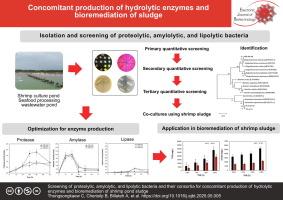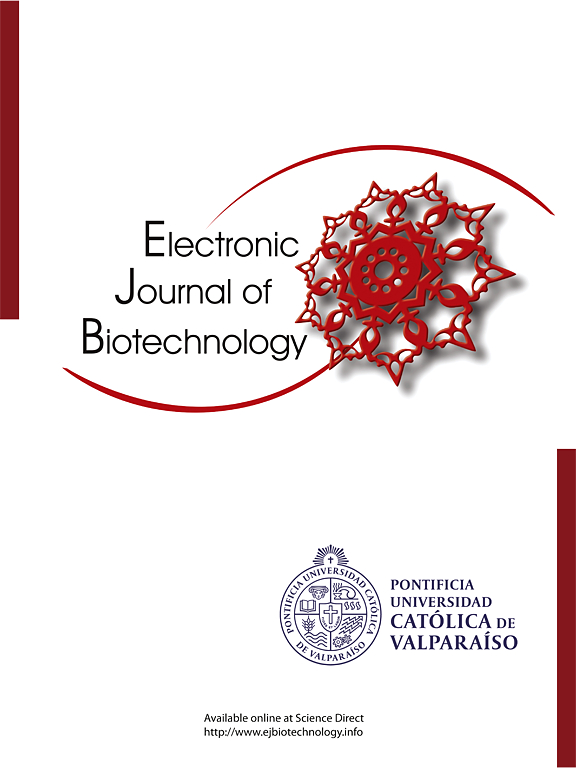蛋白水解、淀粉水解和脂溶菌及其菌群的筛选及其伴随水解酶生产和对虾池污泥的生物修复
IF 2.5
4区 生物学
Q3 BIOTECHNOLOGY & APPLIED MICROBIOLOGY
引用次数: 0
摘要
近几十年来,水产养殖已成为增长最快的部门,这导致了强化的养殖实践,以实现高产量。然而,这种做法引起了人们对其环境影响的关注,因为水产养殖污泥和废水造成了严重的有机污染。本研究旨在分离和筛选蛋白水解菌、淀粉水解菌和脂溶菌,并评估它们的菌群对虾池污泥产酶和生物修复的作用。结果在分离培养基中使用多种底物的策略成功获得了具有多种水解活性的菌株。经过一级和二级定量筛选,筛选出18株具有较高双水解和三重水解活性的分离菌株。利用合成对虾池污泥进行第三次定量筛选和共培养试验,选择了Exiguobacterium indicum SSP-PA-08、Bacillus coagulans和Bacillus subtilis,因为它们协同产生三重水解酶。在总悬浮固体(TSS)含量为0.8%的对虾池污泥中接种后,其蛋白水解活性提高了2.5倍,淀粉水解活性提高了20倍,TSS降低幅度较大。含1.6% TSS的沼液酶产量最高。结论本研究建立了多种产酶细菌的分离方法。在合成虾泥中共培养这些细菌显著提高了水解活性,并导致TSS的更大降低。这些策略对水产养殖污泥的水解酶生产和环境友好型生物修复具有重要意义。引用方式:Thongsongkaew C, Cheirsilp B, Billateh A等。蛋白水解、淀粉水解和脂溶菌及其菌群的筛选及其伴随水解酶生产和对虾池污泥的生物修复。中国生物医学工程学报(英文版);2009;77。https://doi.org/10.1016/j.ejbt.2025.05.005。本文章由计算机程序翻译,如有差异,请以英文原文为准。

Screening of proteolytic, amylolytic, and lipolytic bacteria and their consortia for concomitant production of hydrolytic enzymes and bioremediation of shrimp pond sludge
Background
Aquaculture has become the fastest-growing sector in recent decades, and this has led to intensified cultural practices to achieve high yields. However, such practices have raised concerns regarding their environmental impact, as aquaculture sludge and wastewater cause significant organic pollution. This study then aimed to isolate and screen proteolytic, amylolytic, and lipolytic bacteria and evaluate their consortia for enzyme production and bioremediation of shrimp pond sludge.
Results
The strategy using multiple substrates in the isolation media successfully obtained bacterial strains with multiple hydrolytic activities. After primary and secondary quantitative screening, 18 isolates that exhibited high dual and triple hydrolytic activities were selected. After tertiary quantitative screening using synthetic shrimp pond sludge and co-culture tests, Exiguobacterium indicum SSP-PA-08, Bacillus coagulans, and Bacillus subtilis were selected due to their synergy for the production of triple hydrolytic enzymes. Their consortia inoculated in shrimp pond sludge containing 0.8% total suspended solids (TSSs) showed an increase in proteolytic activity by 2.5 folds and amylolytic activity by 20 folds, which led to a greater reduction in TSS. The highest enzyme production was obtained using shrimp pond sludge containing 1.6% TSS.
Conclusions
This study has developed the methods to isolate bacteria with multienzyme-producing ability. Co-culturing these bacteria in synthetic shrimp sludge significantly enhanced hydrolytic activity and led to a greater reduction in TSS. These strategies may contribute greatly to the hydrolytic enzyme production and environmentally friendly bioremediation of aquaculture sludge.
How to cite: Thongsongkaew C, Cheirsilp B, Billateh A, et al. Screening of proteolytic, amylolytic, and lipolytic bacteria and their consortia for concomitant production of hydrolytic enzymes and bioremediation of shrimp pond sludge. Electron J Biotechnol 2025;77. https://doi.org/10.1016/j.ejbt.2025.05.005.
求助全文
通过发布文献求助,成功后即可免费获取论文全文。
去求助
来源期刊

Electronic Journal of Biotechnology
工程技术-生物工程与应用微生物
CiteScore
5.60
自引率
0.00%
发文量
50
审稿时长
2 months
期刊介绍:
Electronic Journal of Biotechnology is an international scientific electronic journal, which publishes papers from all areas related to Biotechnology. It covers from molecular biology and the chemistry of biological processes to aquatic and earth environmental aspects, computational applications, policy and ethical issues directly related to Biotechnology.
The journal provides an effective way to publish research and review articles and short communications, video material, animation sequences and 3D are also accepted to support and enhance articles. The articles will be examined by a scientific committee and anonymous evaluators and published every two months in HTML and PDF formats (January 15th , March 15th, May 15th, July 15th, September 15th, November 15th).
The following areas are covered in the Journal:
• Animal Biotechnology
• Biofilms
• Bioinformatics
• Biomedicine
• Biopolicies of International Cooperation
• Biosafety
• Biotechnology Industry
• Biotechnology of Human Disorders
• Chemical Engineering
• Environmental Biotechnology
• Food Biotechnology
• Marine Biotechnology
• Microbial Biotechnology
• Molecular Biology and Genetics
•Nanobiotechnology
• Omics
• Plant Biotechnology
• Process Biotechnology
• Process Chemistry and Technology
• Tissue Engineering
 求助内容:
求助内容: 应助结果提醒方式:
应助结果提醒方式:


